| Hormosira banksii | |
|---|---|
 | |
| Young Hormosira | |
| Scientific classification | |
| (unranked): | |
| Superphylum: | |
| Class: | |
| Order: | |
| Family: | |
| Genus: | Hormosira |
| Species: | H. banksii |
| Binomial name | |
| Hormosira banksii | |
Hormosira is a genus of seaweed in the family Hormosiraceae. It is monotypic, with a single species, Hormosira banksii, also known as Neptune's necklace, Neptune's pearls, sea grapes, or bubbleweed)[2] it is native to Australia and New Zealand.[1][3]
Distribution
Hormosira is native to southeastern Australia (including Tasmania, Lord Howe Island and Norfolk Island) and New Zealand.[1][2][3][4][5][6][7] Despite substantial morphological variation across its range, the species represents a single species and the genus Hormosira is monotypic.[5] Genetic analyses of mitochondrial COI and microsatellite DNA sequence data have indicated that there is low genetic variation across the range of the species in Australia.[5][6]
Description
Hormosira is a perennial[4] species of seaweed (brown algae, Fucales).[3] It is abundant on low-energy rocky reefs within the intertidal zone, where it outcompetes other algal species due to its high tolerance to desiccation. Plants vary significantly in morphology.[5] The thallus (or frond) of the species is made up of strings of olive-brown, spherical, gas-filled pneumatocysts (or beads), which taper towards a small holdfast.[2] While the holdfast attaches strongly to a substrate, it can be easily dislodged by human trampling.[4] The spheres are buoyant and rise to the surface of the water during high tide, allowing plants to move with the flow of the current and obtain more sunlight.[8] Hormosira also produces a slime layer to reduce desiccation,[8] and plants often grows in high densities,[4][7] which reduces their surface area exposed to the sun and further reduce dehydration.[8] Due to the buoyant thallus, Hormosira plants can drift out to sea over considerable distances, and floating plants can remain fertile for several weeks.[5]
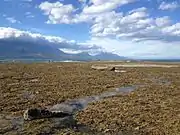 High densities of Hormosira on a broad rocky platform in Kaikoura, New Zealand
High densities of Hormosira on a broad rocky platform in Kaikoura, New Zealand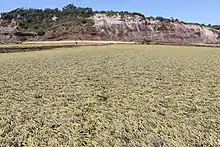 High densities of Hormosira at Long Reef, Sydney, Australia
High densities of Hormosira at Long Reef, Sydney, Australia Hormosira at Eaglehawk Neck, Tasmania, Australia
Hormosira at Eaglehawk Neck, Tasmania, Australia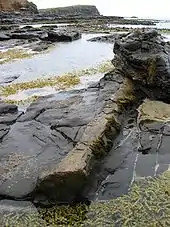 Hormosira growing alongside a petrified log at Curio Bay, Otago, New Zealand
Hormosira growing alongside a petrified log at Curio Bay, Otago, New Zealand
Reproduction
Hormosira reproduces sexually and is monoecious. The sex organs (conceptacles) are on the surface of the beads, and are visible to the naked eye as rough-looking dimples.[9] Hormosira produces eggs throughout the year, but its peak reproduction is often confined to July–October (at least in northern New Zealand) when the sea temperature is around 14 °C, as the viability of the eggs can be low in high sea temperatures such as 17–22 °C.[10] At high tide, the eggs are released directly into the surrounding water. The eggs are negatively buoyant they sink to the substrate to develop for several days before becoming attached.[5] All individuals release at the same time, maximising fertilisation. The species can also reproduce asexually from broken and dislodged fragments.
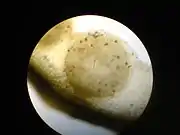 Female conceptacle
Female conceptacle Male conceptacle
Male conceptacle
Ecology
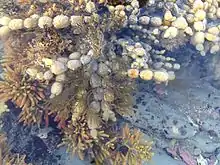
Hormosira is regarded as an ecosystem engineer[6] or habitat former[7] that occurs in large patches and outcompetes other algal species due to its high tolerance to desiccation. Hormosira is a food source for sea urchins, many small crustaceans, and some juvenile fish.[8] Young crustaceans and molluscs often rely on the dense canopies of Hormosira for niche space, protection from predators, and avoid desiccation at low tide.[8] Hormosira provides a substrate for sessile organisms to attach onto, including sea urchins and a wide range of facultative and obligate algal epiphytes such as Notheia anomala.[7] This is beneficial to many organisms as competition for habitat space is a primary limiting factor in the intertidal environment.
Uses
Due to the species high iodine content, Tasmanian schoolchildren were once urged to eat a bead a day to keep the goitres away.[11]
References
- 1 2 3 Huisman, J.M. (2000). Marine Plants of Australia. University of Western Australia Press, Australian Biological Resources Study. ISBN 978-1-876268-33-6.
- 1 2 3 "Hormosira banksii". New Zealand Plant Conservation Network. New Zealand Plant Conservation Network. Retrieved 25 June 2021.
- 1 2 3 W. A., Nelson (2013). New Zealand seaweeds : an illustrated guide. Wellington, New Zealand: Te Papa Press. p. 70. ISBN 9780987668813. OCLC 841897290.
- 1 2 3 4 Schiel, D.R.; Taylor, D.I. (1999). "Effects of trampling on a rocky intertidal algal assemblage in southern New Zealand". Journal of Experimental Marine Biology and Ecology. 235 (2): 213–235. doi:10.1016/S0022-0981(98)00170-1.
- 1 2 3 4 5 6 Mueller, Rebecca; Wright, Jeffrey T.; Bolch, Christopher J.S. (2018). "Historical demography and colonization pathways of the widespread intertidal seaweed Hormosira banksii (Phaeophyceae) in southeastern Australia". Journal of Phycology. 54: 56–65. doi:10.1111/jpy.12599.
- 1 2 3 Bellgrove, Alecia; van Rooyen, Anthony; Weeks, Andrew R.; Clark, Jennifer S.; Doblin, Martina A.; Miller, Adam D. (2017). "New resource for population genetics studies on the Australasian intertidal brown alga, Hormosira banksii: isolation and characterization of 15 polymorphic microsatellite loci through next generation DNA sequencing". Journal of Applied Phycology. 29: 1721–1727. doi:10.1007/s10811-016-1015-0.
- 1 2 3 4 Thomsen, M.S.; Metcalfe, I.; South, P.; Schiel, D.R. (2016). "A host-specific habitat former controls biodiversity across ecological transitions in a rocky intertidal facilitation cascade". Marine and Freshwater Research. 67 (1): 144–152. doi:10.1071/MF14152.
- 1 2 3 4 5 "Neptunes Necklace". Pathwayz. Pathwayz. Retrieved 3 May 2021.
- ↑ "Neptune's necklace". na.oceana.org. Retrieved 17 March 2011.
- ↑ Begum, M.; Taylor, F.J. (1991). "Seasonal egg liberation and potential output of Hormosira banksii". Pakistan Journal of Botany. 23: 145–151.
- ↑ Edgar, Graham (2012). Australian marine life : the plants and animals of temperate waters (2nd ed.). Chatswood, N.S.W.: Reed New Holland. p. 40. ISBN 9781921517174.
External links
- Neptune's necklace discussed in RNZ Critter of the Week, 31 Jul 2020